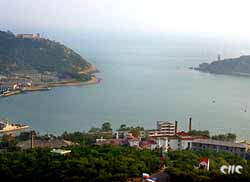
A drive of only half-an-hour takes visitors from Dalian in northeast China's Liaoning Province to the mighty naval fortress of Lvshun.
Situated on the southwest tip of the Liaodong Peninsula, Lvshun enjoys an extraordinary geographic location as the meeting point of the Bohai Sea and the Yellow Sea. Surrounded by the waters of the two seas, the city has a coastline of 169 kilometers and there are many small islands just off it.
In the 19th century, Lvshun (formerly Lvshun Kou to the Chinese and Port Arthur to the Russians) was East Asia's most important naval base and one of the top five naval stations in the world.
As well as its special strategic location, the port was also considered easy to defend and impregnable to attack.
However it was the focal point of attack in two major conflicts, the China-Japan War (1895) and the Russo-Japanese War (1904-05).
In 1895, the Japanese invaded Lvshun and massacred some 200,000 residents in three days. The dead were buried in a mass grave now called the Wangzhong Tomb.
Baiyu Hill is the best position to gain a view of the whole city. On the top is Baiyu Tower, built by the Japanese invaders when they defeated Russia and began their long occupation of the port.
Another tower in the city is Friendship Tower, built to commemorate the help given to China by the former Soviet Union's Red Army in throwing out the Japanese at the end of World War II.
Another historic site is the Russia-Japan Jail which was first built by Russian invaders in 1902 and then expanded by Japanese in 1907. Its 253 cells (each about 5 square meters) housed 2,000 prisoners during the War of Resistance against Japan.
Chinese and Korean prisoners were forced to manufacture munitions for the Japanese army and suffered severely from ill treatment at the hands of the Japanese guards. The slave laborers had to survive on only 150 grams of rice a day.
After visiting these sad reminders of war and occupation, it's time to enjoy the natural beauty of the city and nearby coastline. The city with its many hills is said to be one of China's key nature preservation areas and national forest parks.
Snake Island is a paradise for over 200,000 Pallas pit vipers. The island used to open only for researchers but now travelers are permitted to explore this world of snakes.
Only three sea miles away from Snake Island is a peaceful world for eagles -- Eagle Island is home to thousands of eagles.
From Laotie Hill, one can see clearly the demarcation line between the Bohai Sea and the Yellow Sea: the green water to the northwest is the Bohai Sea and to the blue water to the southwest is the Yellow Sea.
Lvshun is now a naval base for the Marines of the People's Liberation Army and visitors are not allowed to enter parts of the base. However, the eastern part of the harbor has been opened as a park where various naval vessels are on view.
A copper lion in the harbor is the symbol of the naval base.
(Shanghai Star August 12, 2004)
|

